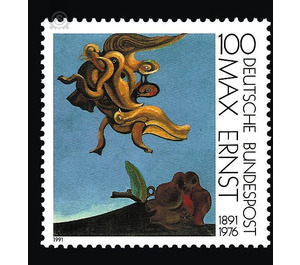100th birthday of Max Ernst - Germany / Federal Republic of Germany 1991 - 100 Pfennig
Theme: Art & Culture
| Country | Germany / Federal Republic of Germany |
| Issue Date | 1991 |
| Face Value | 100.00 |
| Color | blue |
| Perforation | K 13 3/4 |
| Printing Type | 4-color offset printing |
| Stamp Type | Postage stamp |
| Item Type | Stamp |
| Chronological Issue Number | 1442 |
| Chronological Chapter | GER-BRD |
| SID | 436769 |
| In 50 Wishlists | |
Max Ernst, internationally famous for his involvement in the art movements Dadaism and Surrealism, was born on 2 April 1891 in Brühl. Through the father Philipp Ernst, a deaf and dumb man teacher and technically experienced leisure painter, he received his first and only manual information, because after graduation in 1910 he studied art history, classical philology, philosophy, psychiatry, German, Romance, archeology and jurisprudence in Bonn. Max Ernst "lets himself be influenced by everything, lets himself go, gets together again, and so on. Result: chaos in his head," as he later characterized the student years in his autobiography. This openness is also reflected in his early work, in which he tried the different styles of the time - Art Nouveau, Futurism, Fauvism, Cubism - and finally became a member of the Rhenish Expressionists through his friendship with August Macke. Both, study and first orientation in art, ended the First World War, and in a youth memory Max Ernst described his participation as a caesura: "Max Ernst died on August 1, 1914. He returned to life on November 11, 1918 as a young Man, who wanted to become a magician and to find the myth of his time. "The post-war period determined the spiritual revolt of Dadaism, whose main actor in Cologne was Max Ernst until 1921. The use of worthless and for the art of new materials, as well as the ironic and sometimes erotic insanity of his works opened to him a methodical approach, which he never again gave up: indirect way of working and umdeutende view. The visual inventory of the past and the offer of structures of nature became the starting point for new ways of representing and worlds in the work. At the beginning there are overpaintings, cliché drawings and the glued together pictures of illusionistic collages. At the end of 1922, Max Ernst left Cologne with the phrase "30 years of Germany are enough" and found a new circle of friends in the members of the Dada movement in Paris, who in the following years formed a surrealism under André Breton. During the twenties he developed the Frottage and the Grattage - Durchreibezeichnung and Abkratzmalerei - as surrealistic work techniques and led from 1929 with three collage novels this indirect technique to perfection, followed by the Abklatschverfahren the Décalcomanie. In 1937 Max Ernst was defamed by the National Socialists as a "degenerate artist" and interned several times by the Vichy regime as an enemy alien in the late thirties, so that he had to emigrate to the United States in 1941. Here he influenced the American art movement of Abstract Expressionism with an oscillating trickle technique, the dripping, which was an incentive for him to collect images. After the Second World War, his hometown of Brühl held his first major retrospective in Schloss Augustusburg in 1951, but it was the presentation of the "Grand Prize for Painting" at the Venice Biennale in 1954 that gave the now 63-year-old artist his breakthrough and worldwide recognition. Max Ernst, returning to Europe, became a French citizen in 1958 and died on April 1, 1976 in Paris, one day before his 85th birthday. On the occasion of the 100th birthday of Max Ernst, who can rightly be described as a Franco-German artist before the German-French friendship treaty of 1963, the French Post and the Deutsche Bundespost jointly issue stamps showing paintings from 1927. Both motifs belong to the theme group »bird monument« and contain allusions to the Christian iconography: Mother Mary with the baby Jesus and resurrection are indicated in the bird family and in the ascension of feathered beings. (Text: Jürgen Pech, Max Ernst Cabinet, City of Brühl)


